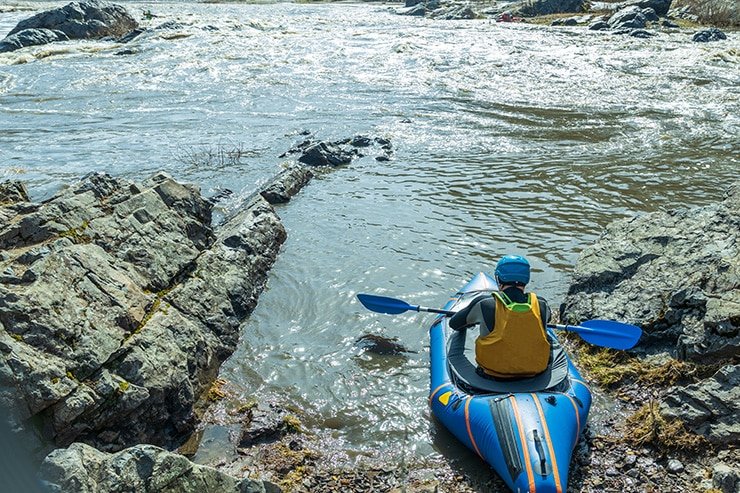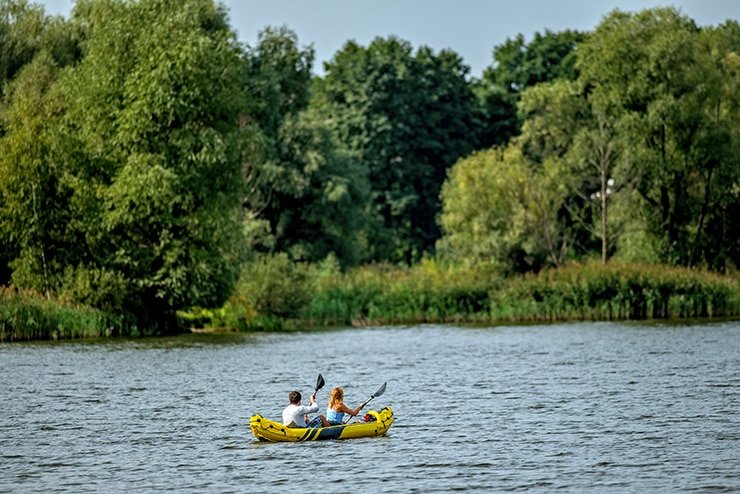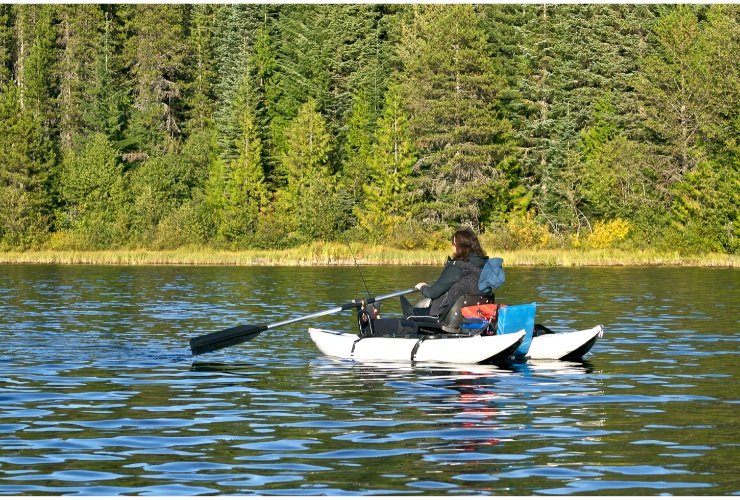Kayaks and inflatable pontoons share some distinct similarities, but they’re designed for different purposes. Both offer unique advantages and disadvantages, and choosing between them often comes down to personal preference and intended use.
Important considerations can include aspects such as portability, stability, maneuverability, storage, and cost. Whether you’re a seasoned water enthusiast or just starting out, this article will help you determine which option is best for your next adventure out on the water.
Key Takeaways
- Kayaks are narrow and long and can be used in various conditions for various activities. They are faster, more maneuverable, and more versatile than pontoons, but also more expensive and harder to transport.
- Inflatable pontoons are supported by two air bladders and a deck that sits higher on the water. They are mainly used for fishing on calm surfaces. They are stable, comfortable, and easy to transport, but also slower, more sensitive to wind, and more prone to punctures.
- Inflatable kayaks are similar to hardshell kayaks in shape and function, but they are more durable, cheaper, and easier to store and transport than hardshells.
- The best option for a water enthusiast depends on their personal preference and intended use. Kayaks offer more control and flexibility, while pontoons offer more comfort and stability.
Kayak vs Inflatable Pontoon: Short Summary of Each
So, which is better? A kayak or an inflatable pontoon?
Unsurprisingly, the answer to this question depends on many things. There’s no clear-cut “better” overall vessel. Each is distinct from the other, and they both usually serve a different purpose, and are used in different ways.
A pontoon is an inflatable boat which is supported by two air bladders, and an inflatable deck that sits higher on the water.
A kayak is a vessel that’s been used as a form of transportation for thousands of years, there are all kinds of different types on the market and they can be used for all kinds of purposes. They sit fairly low in the water and are considered one of the lighter hull types.
What About Inflatable Kayaks?

An inflatable kayak is very similar to hardshell kayaks that you might be familiar with. An inflatable kayak shares the same shape and function, but – as the name suggests – it is inflatable.
An inflatable kayak has its own distinct benefits and advantages when compared with both regular, hard shell kayaks, and inflatable pontoons. Inflatables are durable, hardwearing, easy to transport and less expensive. Plus, they can be deflated and stored easily – which is a big advantage for people who do not have space to store a boat.
It should be noted that a pontoon boat can also come as a hardshell or inflatable but this article will focus on the latter.
Kayaks vs Inflatable Pontoon – What Are The Key Differences?
While they both have unique pros and cons there are also other factors to consider when looking at kayaks and pontoons. Pontoons are not interchangeable with kayaks, most pontoons are used as a fishing vessel and this contributes greatly to their design.
Shape and Handling
Kayaks are narrow and long, and pontoons are broader and stand supported on two air bladders. While this gives the pontoon more height it actually significantly impacts where it can be used.
Without a shadow of a doubt, kayaks have superior handling – regardless of the water conditions kayaks can turn and move much more easily. A pontoon is much more sensitive to changes in the wind and water.
Cost
Kayaks can cost anywhere from around $200 – $300 and reach many thousands. An inflatable pontoon can start from $100 and reach over a thousand dollars. Usually, pricier models give you more durable materials and better accessories.
Versatility
A kayak can be used in a range of conditions and is generally more resilient to changes in water and weather. An inflatable pontoon is generally used in calmer conditions (taking to rough, open seas is generally not a good idea).
Safety
Generally, hard shell kayaks are very stable and secure, but pontoons are also very stable when used in the right conditions.
It’s hard to say who wins in safety overall, as long as you’re using a pontoon on a lake or river in calmer conditions it will be incredibly stable (which is what makes it so popular with recreational fishers).
Kayaks do give you more control and are easier to manoeuvre, which means you can get to and from where you need to go faster and easier.

Transportation
Inflatable pontoons are incredibly easy to transport, they can be deflated and fit in a car. Hard shell kayaks tend to require a bit more effort to move from point to point – including needing to use equipment like roof racks or trailers.
However, inflatable kayaks are very easy to transport – they can be deflated and even fit in a backpack.
Storage and Maintenance
Kayaks have more options for indoor storage – pontoons can be folded and put somewhere but then you also have to make sure that air bladders and other parts don’t get damaged.
Overall, kayaks are significantly easier to maintain than inflatable pontoons. They’re durable and generally less prone to damage.
It should be noted that you can get both inflatable kayaks and pontoons that are very sturdy, Hypalon-based inflatable boats are durable and can last a long time, but these will cost you a lot of money.
Kayak vs Inflatable Pontoon: Pros and Cons Compared
A kayak and an inflatable pontoon are both water-going vessels, but the comparisons stop there. They function differently and generally don’t always share the same purpose. While there are overlaps (fishing kayaks and inflatable pontoons are often compared against each other), kayaks and inflatable pontoons are not interchangeable.
So, let’s compare the pros and cons of each.
Advantages of Kayaks
The main advantages of kayaks are as follows:
- Even on a bad day or in unfavorable conditions, a kayak is faster than an inflatable pontoon. Even a slower, larger vessel like a fishing kayak will outpace the best inflatable pontoon.
- Kayaks don’t require much setup compared to most inflatable boats and this includes pontoons.
- They are easier to maintain and sturdier – this includes inflatable kayaks (pontoons have parts that can potentially come loose). A hard shell kayak is going to be more resilient than most inflatable watercraft, but materials are getting better and better over time.
- More versatility – you can use a kayak in much more varied conditions than you can a pontoon.
- Kayaks are very stable and comfortable once you get the hang of them.
- Kayaks give you options for onboard storage space. If you have fishing gear to move around then kayaks generally have way more storage and capacity.

Disadvantages of Kayaks
But, in the interest of giving a balanced view, it’s important to point out that kayaks also have their shortcomings. The main disadvantages of kayaks are as follows:
- Kayaks can be a bit tricky to transport, usually requiring things like a roof rack or trailer. However, inflatable kayaks are much easier to transport than hardshells.
- Kayaks generally do cost more (but the prices vary dramatically).
- There’s a risk of being capsized, and kayaks being closer to the water makes it more likely for water to get into the vessel.
Advantages of Inflatable Pontoons
Inflatable pontoons have their positive points, and could be the right vessel for someone with a specific set of criteria. The main advantages of inflatable pontoons are as follows:
- Easy to transport – an inflatable pontoon can be broken down and easily fit into a car.
- Very stable – but in calm conditions only – which is what makes them popular for people who have a favorite fishing spot on a calm lake.
- You dn’t sit as close to the water as with a kayak – which means better comfort and better line of sight in some situations.
- Inflatable pontoons can be quite inexpensive (especially if they’re PVC based).
Disadvantages of Inflatable Pontoons
While inflatable pontoons do have their positive points, they are by no means perfect for every person or situation. The main disadvantages of inflatable pontoons are as follows:
- A pontoon boat will be slower than a kayak – they’re built to be a stable platform and not for speed.
- Both inflatable boats (inflatable kayaks and pontoons) take time to set up, but the pontoon will take longer.
- Punctures are a possibility if you hit a sharp or craggy surface/structure.
- Pontoons do not do well in windy conditions and will slow down dramatically.
| Kayaks | Inflatable Pontoons | |
| Advantages | Kayaks are faster.Barely any set-up (and only a tiny bit for inflatable kayaks). Easy to maintain. Versatile.Stable and comfortable. Storage space. | Easy to transport. Stable (in good conditions). Further from the water. Can be cheap. Potential trolling motor upgrades. |
| Disadvantages | Can be trickier to transport. More expensive.Risk of capsizing/water getting into the vessel. | Longer set-up time. Can puncture. Bad weather will slow down/reduce stability a lot. |
Conclusion
Both kayaks and inflatable pontoons have their strengths and weaknesses. The best option for you depends on what you plan to do on the water. Fishing on calm surfaces is great with an inflatable pontoon. However, if you plan to do anything else then a kayak will serve you well.
Thank you for reading and please like, comment, or share if you’ve found the information here useful.

